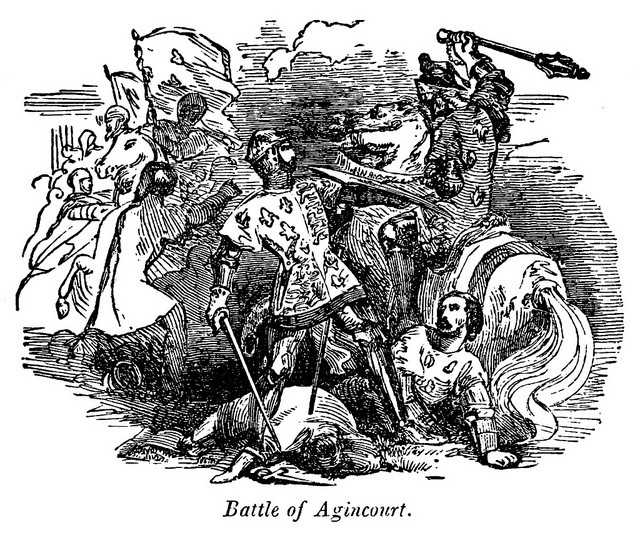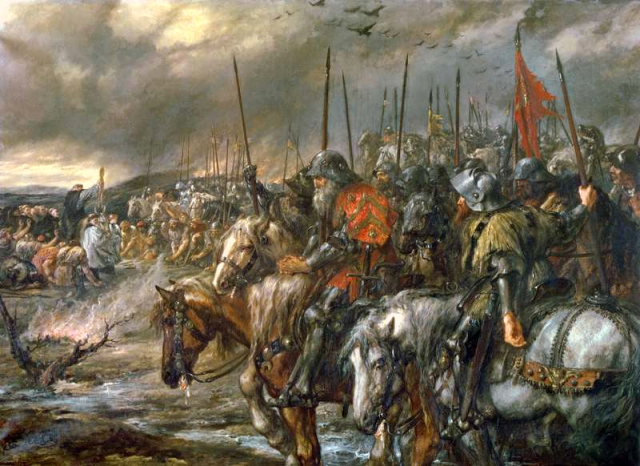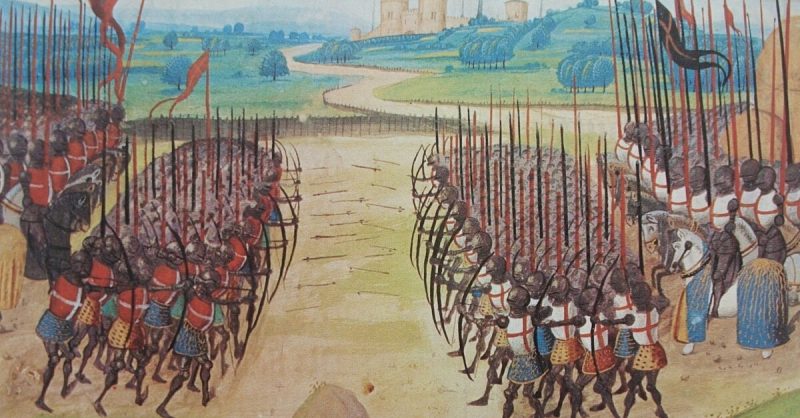The Battle of Agincourt is an iconic moment in English military history. On 25 October 1415, an army of English raiders under Henry V faced the French outside an obscure village on the road to Calais. Humble English archers defeated the armoured elite of French chivalry, enshrining both the longbow and the battle in English national legend.
Half the reason why Agincourt is so famous is that the English won against the odds. So why should they have lost, and ultimately why did they win?
1. Weight of Numbers
Sizes of medieval armies are never more than estimates, due to the lack of accurate documents. Despite this, the English were clearly outnumbered at least four or five to one.
The English army at Agincourt consisted of around 900 men-at-arms and 5000 archers – a total of 6000 armed men. The French, on the other hand, brought 25000 or more, a number that may not have included their own archers and crossbowmen. The sheer weight of numbers gave them a huge edge.
2. Men-at-Arms

Battlefields of the period were dominated by men-at-arms, a hard-hitting professional military force. Though not all of them held the rank of knight, these are the men we picture when we talk about medieval knights. Society’s traditional warrior elite, they were raised from childhood to the art of war. Many were experienced soldiers – the French men-at-arms had been fighting the English on and off for nearly a century, as well as fighting in their nation’s internal conflicts and local feuds.
Richer than common foot soldiers, men-at-arms were well equipped for battle. In particular, they wore heavy armour, which increasingly consisted of full plate. Even longbow arrows could seldom penetrate this armour except at close range, letting the wearers charge safely into the fray.
Men-at-arms made up perhaps a sixth of the English army, but the vast majority of the French force. By the military logic of the day, the French troops were superior in quality as well as numbers.
3. Disease
The English army had come from Harfleur, where they had spent over a month besieging the town. Camped in marshy ground outside the walls, many men had fallen ill. Around 2000 died of dysentery before they even took Harfleur, contributing to the small size of the army that then marched on toward Calais. Many more were still sick by the time they faced the French – weak, uncomfortable and suffering from diarrhoea. Some English archers went into battle naked from the waist down, having had to throw away ruined hose or set clothes aside for easy access on emergency toilet runs.
4. Hunger
When the English set out from Harfleur on 6 October they took eight days of supplies, leaving their baggage train behind for a fast march. They pillaged the farms and countryside they passed, but the pressure of a French pursuit forced them to keep up their pace, and by the time of the battle they had been short of food for the past week. These were not well fed men full of carbohydrates and the energy they bring. Though King Henry and those close to him still fed well, many in his army fought on half-empty bellies.
5. Exhaustion
The march from Harfleur was a gruelling one. On reaching the Seine, the English army’s way was blocked by the French, who prevented them from crossing. The other army then dogged their progress for the rest of the journey, keeping them on alert and unable to rest. The march became longer and slower, hampered by pouring rain that turned the unpaved roads to mud and left the common infantry sleeping in puddles under hedges. B y Agincourt they were exhausted as well as ill and hungry.
6. French Caution

The French are not generally noted for their caution at Agincourt, where they charged relentlessly into a hail of English arrows. But they had shown strategic caution leading up to the battle.
Rather than rush straight at Henry and his men, the French commanders sought to block his advance. By destroying river crossings and obstructing the English advance, they forced the enemy to come to them while giving themselves more time to prepare.
On 24 October, they finally decided it was time to fight, to smash Henry’s army and stop him escaping France. They moved onto the Calais road ahead of the English, stopping them in their tracks.
Late that day, Henry ordered his troops to take up defensive positions on a ridge crossing the road. They stood no chance attacking the French head on, but if they could fight on favourable ground they might at least survive. It was tempting for the French to immediately attack, but they had learned some caution from their previous encounters with the English at Crecy and Poitiers. Rather than attack late in the day, giving them less time to wear the English down with their superior numbers, they set up camp and waited to attack when dawn came.
What Made the Difference?
The victory was France’s to lose, so what went wrong?
In retrospect, we can see that the French were clinging to outmoded ways of fighting. The tactical superiority of charges by heavily armed men-at-arms had been on the decline for over a century. Defensive infantry tactics using spears and bows were now bringing victories all over the continent, not least in similar engagements at Crecy and Poitiers earlier in the Hundred Years War.
The benefits of these infantry tactics were made invaluable by the truly decisive factor in the battle – leadership.
The French leaders were disorganised and divided. Two factions were competing to rule the country, and their adherents struggled to work together. Aristocratic pride led important men to charge straight in rather than focus on coordinating others.
The English, on the other hand, had one clear leader under Henry. His charisma and successes made him popular among his men. He chose his ground carefully, positioned his men wisely, and when the time came he joined the French nobility in inspiring the troops by leading from the front.
The right leader, a proper leadership structure, and the right troops for the job combined to give the English victory, and rob the French of a triumph that should have been theirs.
